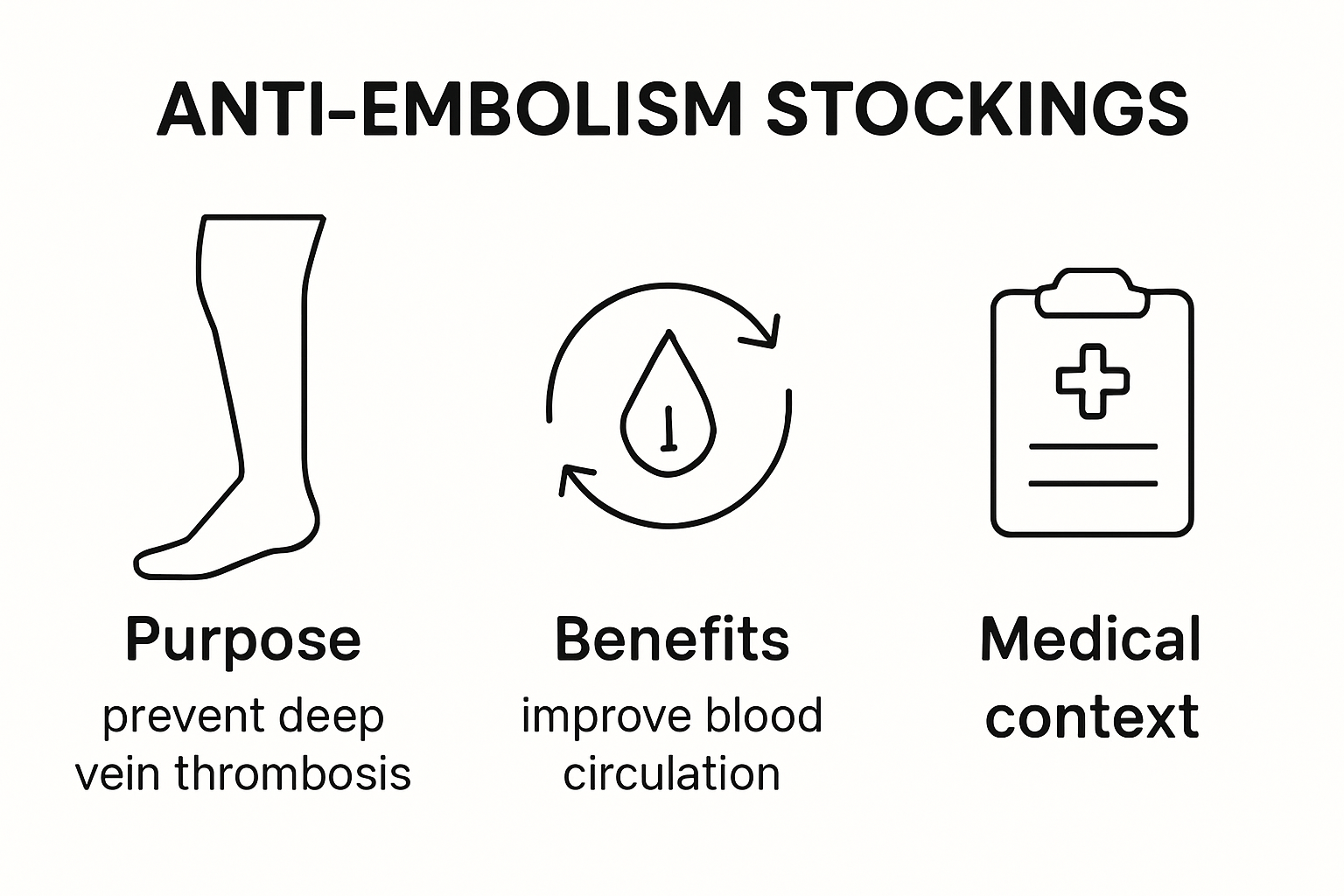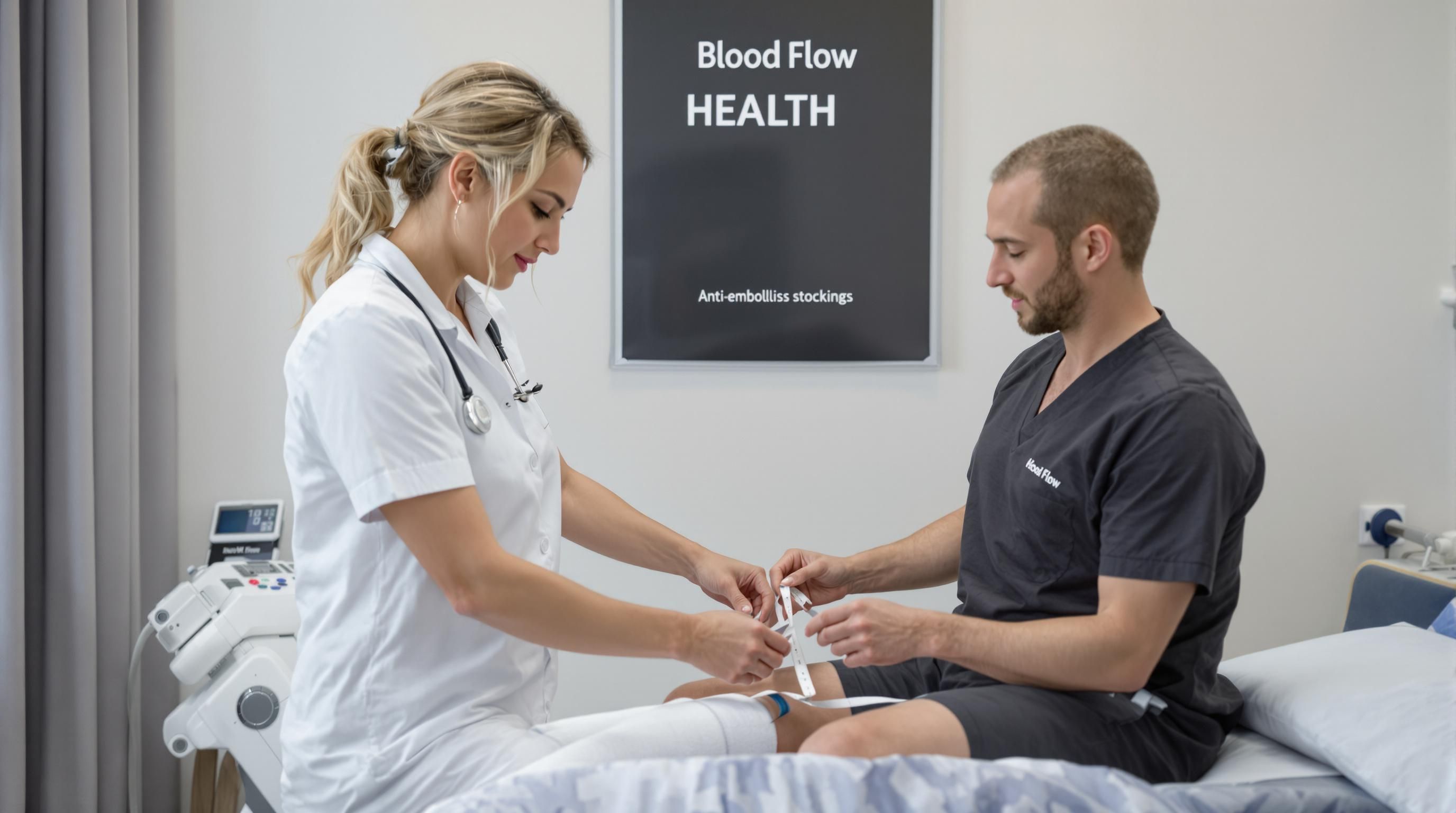
What Are Anti Embolism Stockings? Essential Guide 2025
Share

Anti embolism stockings are often seen in hospitals and recovery rooms, protecting patients when movement is limited. Most people know they reduce the risk of blood clots, but studies show that over 50 percent of surgical patients actually need them for effective DVT prevention. Surprising right? What many do not expect is that using these stockings without proper medical assessment or the wrong size can actually do more harm than good.
Table of Contents
- Understanding What Are Anti Embolism Stockings
- Who Should Use Anti Embolism Stockings
- How Anti Embolism Stockings Work For Circulation
- Choosing And Safely Using Anti Embolism Stockings
Quick Summary
| Takeaway | Explanation |
|---|---|
| Anti embolism stockings prevent DVT. | They are designed to reduce the risk of deep vein thrombosis during immobility. |
| Proper fitting is crucial. | Ill-fitting stockings can lead to inadequate compression or skin damage. |
| Use requires professional guidance. | Always consult a healthcare provider for assessment before usage. |
| Follow application techniques carefully. | Smooth out wrinkles and ensure correct positioning for effectiveness. |
| Monitor skin condition regularly. | Check daily for any skin breakdown or discomfort to avoid complications. |
Understanding What Are Anti Embolism Stockings

Anti embolism stockings represent a critical medical intervention designed to prevent serious circulatory complications. These specialized compression garments play a pivotal role in protecting patients from potentially life-threatening conditions associated with blood circulation disruptions.
The Fundamental Purpose of Anti Embolism Stockings
Anti embolism stockings are engineered to address a specific medical challenge: reducing the risk of deep vein thrombosis (DVT) and blood clot formation. Research from the National Center for Biotechnology Information indicates these stockings are particularly crucial for patients who are immobile or recovering from surgical procedures. The primary mechanism involves applying graduated compression to the leg, which helps promote blood flow and prevents blood from pooling in the lower extremities.
The design of these stockings is strategically sophisticated. They apply controlled pressure that is strongest at the ankle and gradually decreases as the stocking moves up the leg. This graduated compression mimics the natural muscle pump action of walking, encouraging blood to move back toward the heart even when a patient is stationary. By supporting venous return, these stockings significantly reduce the risk of blood clot formation.
Medical Conditions and Scenarios Requiring Anti Embolism Stockings
Various medical scenarios necessitate the use of anti embolism stockings. Clinical studies published in the Journal of Vascular Surgery highlight their importance in multiple clinical contexts. Patients undergoing major surgeries, particularly orthopedic or abdominal procedures, are prime candidates. Individuals with limited mobility due to injury, chronic illness, or post-operative recovery also benefit tremendously from these specialized compression garments.
Beyond surgical scenarios, patients with specific medical conditions require anti embolism stockings. These include individuals with a history of blood clots, those with compromised circulatory systems, pregnant women experiencing reduced mobility, and patients with chronic venous insufficiency. The stockings provide a non-invasive, proactive approach to managing potential circulatory complications.
For patients seeking comprehensive support, our guide to compression therapy offers additional insights into managing circulatory health effectively. Understanding the nuanced role of these medical garments can help patients make informed decisions about their personal health management strategies.
Who Should Use Anti Embolism Stockings
Anti embolism stockings are not a universal solution for everyone. Understanding the specific medical scenarios and patient profiles that benefit from these specialized compression garments is crucial for effective health management.
Surgical Patients and Post-Operative Recovery
Cambridge University Hospitals recommend anti embolism stockings for patients undergoing major surgical procedures. Individuals scheduled for lengthy operations, particularly orthopedic or abdominal surgeries, are prime candidates. These stockings help prevent potentially life-threatening blood clots during periods of extended immobility associated with surgical recovery.
Patients experiencing reduced mobility after surgery face increased risks of deep vein thrombosis. Surgical interventions that limit movement create an environment where blood can pool in the lower extremities, making anti embolism stockings a critical preventative measure. Orthopedic procedures like hip or knee replacements, spinal surgeries, and extensive abdominal operations particularly benefit from this protective intervention.
Medical Conditions Requiring Compression Support
The National Institute for Health and Care Excellence provides comprehensive guidance on medical conditions warranting anti embolism stockings. Patients with specific health challenges are recommended to use these specialized garments. These include individuals with:
- Limited mobility due to chronic illness
- Extended bed rest periods
- History of blood clotting disorders
- Pregnancy complications involving reduced movement
- Chronic venous insufficiency
However, it is crucial to note that certain medical conditions contraindicate the use of anti embolism stockings. Research published in the Postgraduate Medical Journal highlights specific scenarios where these stockings should not be used, such as:
- Congestive cardiac failure
- Peripheral arterial disease
- Peripheral neuropathy
- Active skin ulcerations
- Severe inflammatory skin conditions
The table below summarizes recommended uses and contraindications for anti embolism stockings to help clarify which patient groups may benefit from or should avoid their use.
| Situation or Condition | Recommended? | Notes |
|---|---|---|
| Major surgery (orthopedic, abdominal) | Yes | Key preventive measure during recovery |
| Limited mobility (injury, illness, bed rest) | Yes | To reduce risk of blood clots |
| Pregnancy with reduced movement | Yes | Consult healthcare provider |
| History of blood clotting disorders | Yes | Essential for many patients |
| Chronic venous insufficiency | Yes | Provides proactive support |
| Congestive cardiac failure | No | Use contraindicated |
| Peripheral arterial disease | No | Use contraindicated |
| Peripheral neuropathy | No | Use contraindicated |
| Active skin ulcerations or severe inflammation | No | Use contraindicated |
Professional Medical Guidance and Individual Assessment
Determining the appropriateness of anti embolism stockings requires professional medical evaluation. Healthcare providers assess individual patient risks, medical history, and specific physiological conditions to recommend the most suitable compression strategy. Our comprehensive guide to compression therapy provides additional insights into personalized compression solutions.
Patients should never self-prescribe anti embolism stockings. A thorough consultation with a healthcare professional ensures proper sizing, compression level, and appropriateness for individual medical needs. Regular monitoring and potential adjustments are essential to maximize the therapeutic benefits while minimizing potential risks associated with incorrect usage.
How Anti Embolism Stockings Work for Circulation

The mechanics behind anti embolism stockings represent a sophisticated approach to supporting the body’s circulatory system. These specialized garments utilize precise compression techniques to address potential blood flow challenges and promote optimal venous return.
Graduated Compression Mechanism
Research from the Venous Forum reveals that anti embolism stockings employ a strategic graduated compression design. This means the compression is strongest at the ankle and gradually decreases as the stocking moves up the leg. The pressure gradient mimics the natural muscle pump action of walking, effectively encouraging blood to move against gravity and return to the heart.
The compression works by applying external pressure to the veins, which helps prevent blood from pooling in the lower extremities. When muscles are inactive, such as during extended bed rest or surgical recovery, these stockings provide the mechanical support typically generated by muscle contractions. By maintaining consistent pressure, they reduce the diameter of distended veins, increasing blood flow velocity and preventing potential clot formation.
Physiological Response and Blood Flow Improvement
Cambridge University Hospitals explain that the physiological impact of anti embolism stockings extends beyond simple pressure application. The compression stimulates several critical circulatory responses. First, it reduces venous diameter, which increases blood flow speed and prevents stasis. Second, the pressure helps close off potential pathways for clot development by maintaining vein wall tension.
Patients with limited mobility experience significant benefits from this mechanical intervention. The stockings essentially replace the pumping action typically created by walking, ensuring that blood continues to circulate efficiently even when a person cannot move. This is particularly crucial for patients recovering from surgery or experiencing prolonged periods of immobility.
Precision and Individual Adaptation
Not all compression is created equal. The effectiveness of anti embolism stockings depends on precise measurement and individual physiological characteristics. Our comprehensive compression fitting guide provides insights into selecting the right compression level and ensuring proper fit.
Healthcare professionals carefully assess factors like limb circumference, overall health condition, and specific medical risks when recommending these stockings. The goal is to provide just enough compression to support circulation without causing additional complications. Some patients may require custom-fitted stockings that account for unique anatomical variations or specific medical conditions.
Understanding the intricate way anti embolism stockings support circulation helps patients appreciate their role in preventive healthcare. These are not mere garments but sophisticated medical tools designed to protect and support the body’s most critical transportation system: the circulatory network.
Choosing and Safely Using Anti Embolism Stockings
Selecting and utilizing anti embolism stockings requires careful consideration and precise application. Understanding the nuanced process of choosing and wearing these specialized medical garments is crucial for maximizing their therapeutic potential and ensuring patient safety.
Professional Assessment and Proper Sizing
Nursing Times clinical guidelines emphasize the critical importance of professional measurement and individual assessment when selecting anti embolism stockings. Healthcare providers must conduct comprehensive evaluations that include measuring leg circumference, assessing skin condition, and determining the appropriate compression level based on specific medical needs.
Precise sizing is paramount. Ill-fitting stockings can either provide insufficient compression or create potentially harmful pressure points. Measurements should be taken in the morning when leg swelling is minimal, and multiple points of the leg must be measured to ensure a custom fit. Our comprehensive compression fitting guide offers detailed insights into obtaining accurate measurements and selecting the right stocking size.
The following table summarizes the key steps for correctly measuring and fitting anti embolism stockings, as described in clinical guidelines:
| Measurement & Fitting Step | Description |
|---|---|
| Measure in morning | Take measurements when leg swelling is minimal |
| Measure multiple points on leg | Assess circumference at ankle, calf, and thigh as needed |
| Assess skin condition | Ensure skin is healthy before fitting |
| Select appropriate compression level | Choose based on medical assessment and patient needs |
| Ensure proper fit | Stockings should not cause discomfort, excessive pressure, or roll down |
Correct Application and Usage Techniques
The National Institute for Health and Care Excellence provides specific guidelines for the correct application of anti embolism stockings. Proper wearing techniques are as crucial as selecting the right size. Patients and healthcare providers must follow a meticulous process that includes:
- Ensuring clean, dry skin before application
- Smoothing out any wrinkles to prevent skin irritation
- Pulling the stocking up carefully without creating excessive tension
- Checking for proper alignment and smooth fabric distribution
- Avoiding folding or rolling down the top band
Patients should be educated about potential signs of improper fitting, such as discomfort, skin discoloration, or reduced circulation. Regular monitoring and periodic reassessment are essential to ensure ongoing effectiveness and patient comfort.
Safety Considerations and Potential Risks
A clinical audit examining anti embolism stocking usage highlighted critical safety considerations that patients and healthcare providers must understand. While these stockings are designed to prevent complications, improper use can lead to potential risks.
Key safety recommendations include:
- Removing stockings daily for skin inspection
- Checking for any signs of skin breakdown or pressure marks
- Washing stockings according to manufacturer instructions
- Replacing stockings at recommended intervals
- Consulting healthcare professionals if any discomfort or unusual symptoms occur
Some patients may have contraindications that make anti embolism stockings inappropriate. Individuals with severe peripheral arterial disease, significant skin conditions, or extreme sensitivity require specialized medical guidance. Healthcare providers must conduct thorough assessments to determine individual suitability.
Ultimately, anti embolism stockings are sophisticated medical tools that demand respect, proper understanding, and careful implementation. Patients should view them as an integral part of their healthcare strategy, not merely as a passive garment, but as an active component of their circulatory health management.
Frequently Asked Questions
What are anti embolism stockings?
Anti embolism stockings are specialized compression garments designed to prevent deep vein thrombosis (DVT) and blood clots, particularly in patients who are immobile or recovering from surgery. They apply graduated compression to the legs, encouraging blood flow back to the heart.
Who should use anti embolism stockings?
Anti embolism stockings are recommended for surgical patients, individuals with limited mobility, those recovering from specific medical conditions, pregnant women experiencing reduced movement, and people with a history of blood clots. However, they may not be suitable for everyone, so professional assessment is essential.
How do anti embolism stockings work to improve circulation?
These stockings utilize a graduated compression mechanism that applies the most pressure at the ankle and gradually decreases up the leg. This mimics the natural muscle pump action of walking, preventing blood from pooling and promoting efficient blood flow.
What should I consider when choosing and using anti embolism stockings?
When choosing anti embolism stockings, it’s crucial to have a professional assessment for proper sizing and compression level. Proper application techniques should be followed, and regular monitoring for any skin issues or discomfort is essential for safety.
Take the Next Step to DVT Prevention and Effective Compression Therapy
You have just learned why properly fitted anti embolism stockings matter and how choosing the right size and compression can help lower your risk of serious health complications. The challenge many face is finding quality stockings that fit well and truly deliver the support your doctor recommends. Without professional assessment and the right product, you risk discomfort or even new problems instead of improved circulation and safety.
At Fit Stockings, we remove the guesswork, offering a broad selection of medical-grade compression stockings trusted by leading hospitals and doctors nationwide. Discover brands like Jobst, available in a variety of compressions and styles for every medical need, including post-surgery and long periods of immobility. Your recovery and comfort are our priority. With fast shipping, expert sizing guidance, and easy returns, now is the perfect time to browse our collection or visit Fit Stockings for personalized solutions. Choose safe, effective compression that makes a real difference. Shop today and put your health first.
Recommended
- The Ultimate Guide to Compression Stockings: Comfort, Health, and Styl – Fit Stockings
- Compression Stockings Fitting Guide 2025: Find the Perfect Fit – Fit Stockings
- Knee High Compression Stockings: Health Benefits and Guide 2025 – Fit Stockings
- The Ultimate Guide to Compression Stockings: What They Are and Who Nee – Fit Stockings

